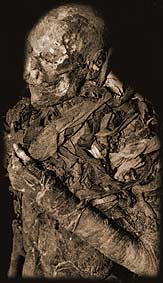Tomb
description
This
is a small tomb, the corridor - 5 metres long - leads into the
burial chamber 4 X 5 metres. All rooms are uninscribed, the tomb
was found two female mummies and some mummified geese. Each of
the niches along the side of the corridor held a wedjat-eye inscribed
onto the wall, one looked towards the burial chamber the other
two looked towards the tomb entrance.
Tomb
Discovery and contents
Howard
Carter (while working for Theodore Davis) discovered this tomb
in 1903, on entering the tomb he found that it had been robbed
in antiquity and the contents pretty much destroyed. Carter then
reclosed the tomb as he continued his search in the Valley of
the Kings for a royal burial.
In 1906
the tomb was re-entered by Edward Ayrton who removed one of the
mummies - that of Hatshepsut's wet nurse, Sitre In - to the Cairo
Museum. The second mummy was left in the tomb.
The tomb
was not to be entered again until the 1980's, Donald Ryan then
entered the tomb and removed the second mummy - it was found
to have been quite fat in life, her original hair, which had
fallen off over time, was found underneath where her head lay.
The most interesting point about this mummy is the positioning
of the arms - the right arm was crossed over the breast which
suggests royalty, Elizabeth Thomas has used this arm positioning
(and the fact of the mummy being found in the tomb of Sitre In)
as evidence that the mummy is that of Hatshepsut herself (her
mummy could have been hidden here after her death to escape the
vengenance of Tuthmosis III). This mummy was placed inside a purpose built coffin by Ryan and remains still in the tomb.
 �
�
Could this be the mummy of Hatshepsut?
(Picture by kind permission of Donald Ryan - Click Here for his website)


